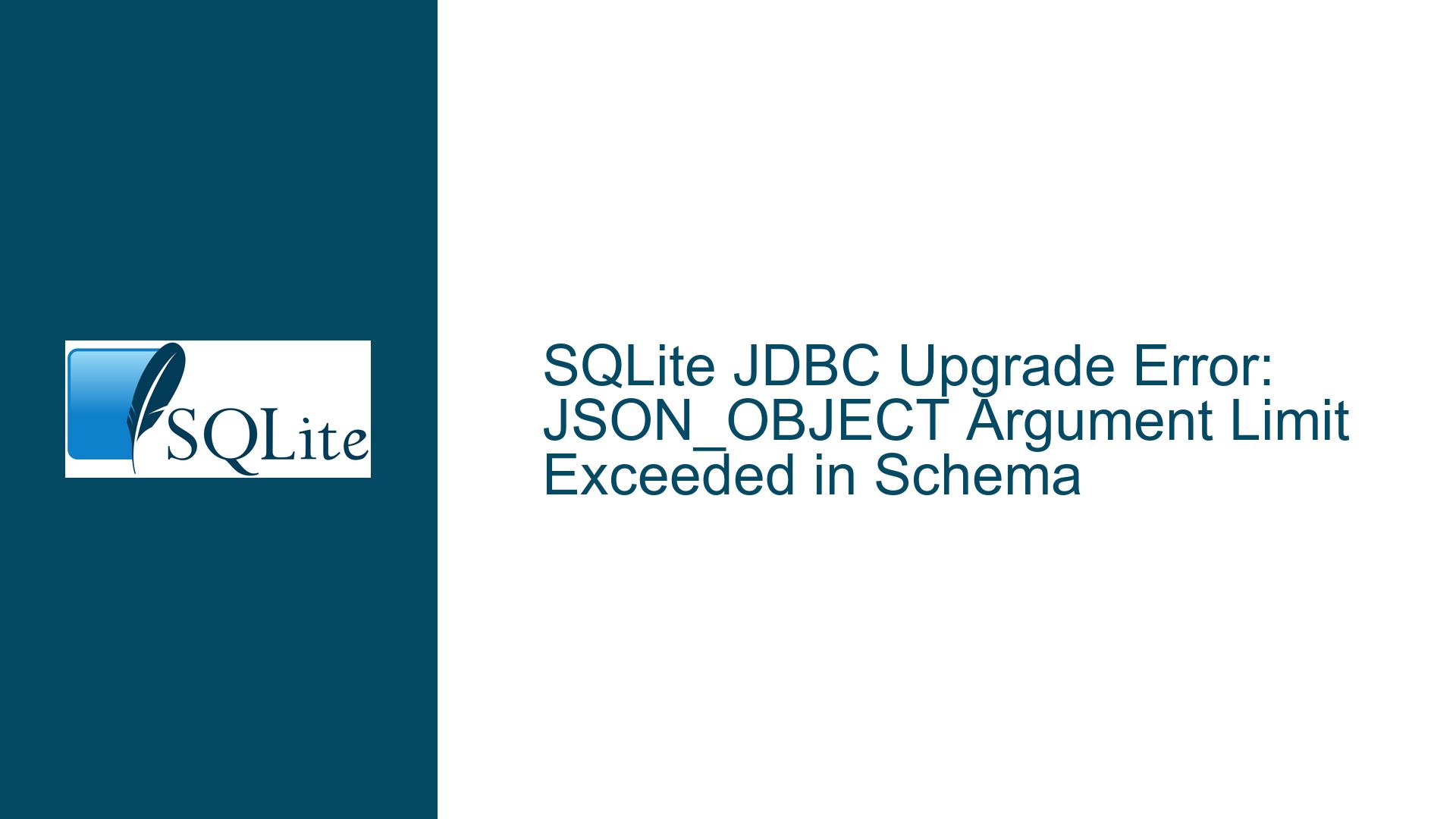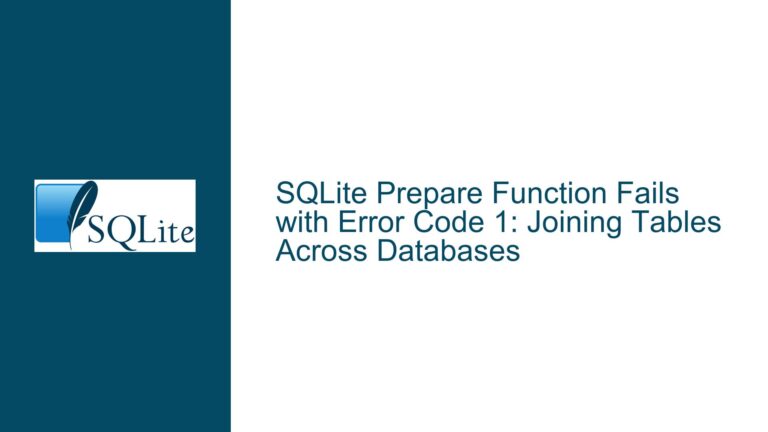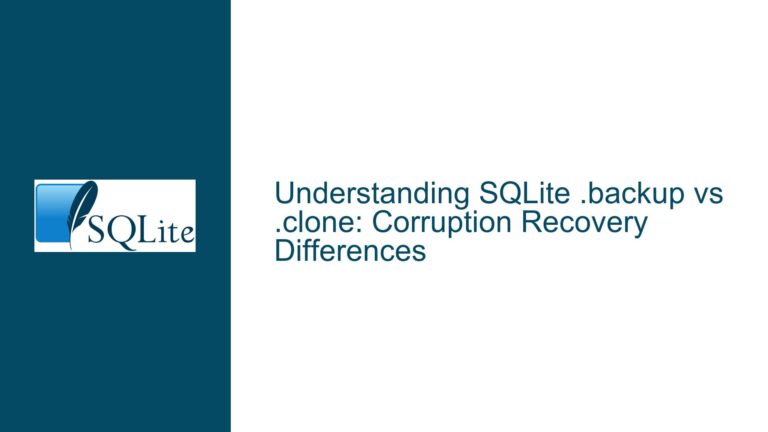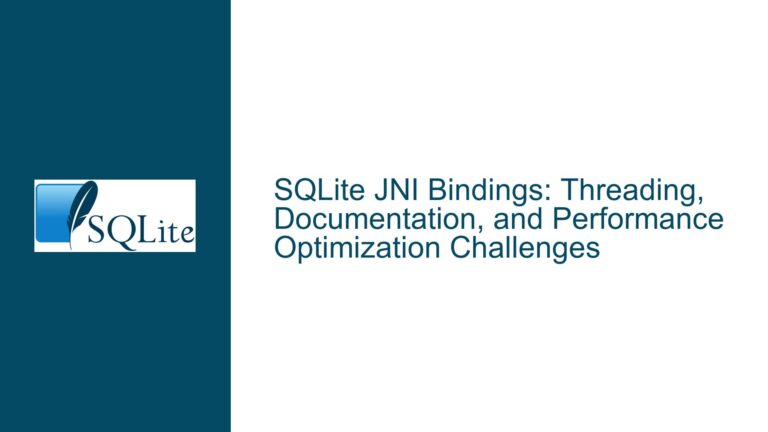SQLite JDBC Upgrade Error: JSON_OBJECT Argument Limit Exceeded in Schema
Understanding the "Malformed Schema" Error Due to JSON_OBJECT Argument Limits
Issue Overview: Excessive JSON_OBJECT Arguments Triggering Schema Corruption Errors
When upgrading the SQLite JDBC driver (e.g., from 3.34.0 to 3.36.0.3), applications may encounter the error:
org.sqlite.SQLiteException: [SQLITE_CORRUPT] (malformed database schema (my_insert_trg) - too many arguments on function JSON_OBJECT).
This error occurs because the JSON_OBJECT function in SQLite’s JSON1 extension is being called with more arguments than allowed by the SQLITE_MAX_FUNCTION_ARG limit configured in the JDBC driver. The error misleadingly references schema corruption because SQLite validates schema objects (e.g., triggers, views) that reference invalid functions. If a trigger (my_insert_trg in this case) uses JSON_OBJECT with too many arguments, SQLite flags the schema as malformed during database initialization.
The root cause lies in a JDBC driver configuration mismatch:
- Older JDBC drivers (e.g.,
3.34.0) may have allowed higher argument limits (e.g.,127). - Newer drivers (starting with
3.36.0.3) might enforce a lower limit (e.g.,100) due to changes in the driver’s compilation settings or runtime defaults.
The JSON_OBJECT function requires an even number of arguments (key-value pairs). For example, JSON_OBJECT('a',1,'b',2) uses four arguments (two pairs). If a call to JSON_OBJECT exceeds the argument limit, SQLite rejects it, invalidating any schema object (like a trigger) that depends on it.
Possible Causes: Why the Argument Limit Is Exceeded
JDBC Driver Compilation Settings:
- The
SQLITE_MAX_FUNCTION_ARGlimit is set at compile time. If the JDBC driver vendor (e.g., Xerial) compiles SQLite with a lower limit (e.g.,100), applications usingJSON_OBJECTwith more than50key-value pairs (100 arguments) will fail. - Example: A
JSON_OBJECTcall with64pairs (128 arguments) exceeds the default limit of100in newer drivers.
- The
Schema Validation on Database Open:
- SQLite checks the validity of schema objects (triggers, views) when opening the database. If a trigger references an invalid function call (due to argument limits), the entire schema is flagged as corrupt.
Implicit Argument Counting in Complex Queries:
- Nested
CASEstatements, computed columns, or subqueries inJSON_OBJECTcan inadvertently increase the argument count.
- Nested
Runtime Limit Reductions:
- Even if SQLite is compiled with a high limit (e.g.,
127), third-party drivers or frameworks might lower it at runtime viasqlite3_limit(SQLITE_LIMIT_FUNCTION_ARG, 100).
- Even if SQLite is compiled with a high limit (e.g.,
Troubleshooting Steps, Solutions, and Fixes
Step 1: Verify the JSON_OBJECT Argument Count
Inspect all JSON_OBJECT calls in the schema and application code. For example, the Cloud_json_table insertion query includes a JSON_OBJECT with over 60 key-value pairs (120+ arguments). Use a text editor or SQL parser to count arguments:
JSON_OBJECT(
'chat_subject', [chat_subject],
'encryptFileKey', [encryptFileKey],
'f_email_id', [f_email_id],
... 60+ more pairs ...
)
If the count exceeds 100 arguments (50 pairs), this is the issue.
Step 2: Check the JDBC Driver’s SQLITE_MAX_FUNCTION_ARG Limit
Compile-Time Limit:
SQLite’s defaultSQLITE_MAX_FUNCTION_ARGis127, but JDBC drivers may override this. Check the driver’s documentation or source code.
Example: Xerial’ssqlite-jdbc-3.36.0.3setsSQLITE_MAX_FUNCTION_ARG=100at compile time.Runtime Limit:
Even if compiled with127, drivers might lower the limit. Use the SQLite CLI to check:SELECT sqlite3_limit(sqlite3_db_handle(), 6); -- 6 = SQLITE_LIMIT_FUNCTION_ARG
Step 3: Adjust the Function Argument Limit
If the driver allows runtime configuration, increase the limit before executing schema-related queries:
// Java example for Xerial JDBC
SQLiteConnection conn = (SQLiteConnection) DriverManager.getConnection("jdbc:sqlite:mydb.db");
conn.setLimit(SQLiteLimits.SQLITE_LIMIT_FUNCTION_ARG, 127);
Step 4: Refactor JSON_OBJECT Calls
Split large JSON_OBJECT calls into smaller ones and merge with json_patch() or json_set():
-- Original (120 arguments):
JSON_OBJECT('a',1,'b',2,...60 pairs)
-- Refactored:
json_patch(
JSON_OBJECT('a',1,'b',2,...30 pairs),
JSON_OBJECT('c',3,'d',4,...30 pairs)
)
Step 5: Validate Schema Integrity
After fixing the queries, run:
PRAGMA integrity_check;
Resolve any lingering corruption errors by recreating affected triggers or views.
Step 6: Downgrade or Custom-Build the JDBC Driver
If runtime adjustments are impossible:
- Downgrade to a JDBC driver with a higher
SQLITE_MAX_FUNCTION_ARGlimit. - Compile a custom SQLite build with
-DSQLITE_MAX_FUNCTION_ARG=200and integrate it into the JDBC driver.
Step 7: Optimize JSON Schema Design
Avoid excessively flat JSON structures. Use nested objects or separate tables for rarely accessed fields.
Final Notes:
The error is not caused by database corruption but by overly strict argument limits in newer JDBC drivers. By adjusting limits, refactoring queries, and validating the schema, applications can resume normal operation without downgrading SQLite versions. Always test JDBC driver upgrades in a staging environment to catch similar issues early.






